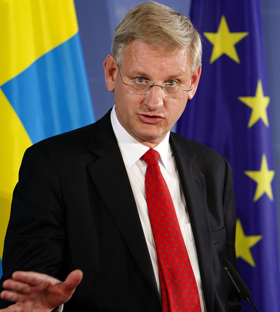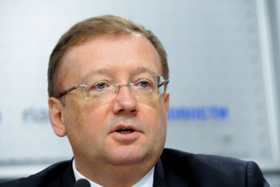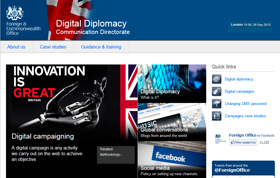Digital diplomacy: areas of work, risks and tools
In
Login if you are already registered
(votes: 4, rating: 3) |
(4 votes) |
PhD in Political Science, Diplomatic Academy of the Russian Ministry of Foreign Affairs
At a meeting of ambassadors and permanent representatives in June 2012, Russian President Vladimir Putin put digital diplomacy among the most effective foreign policy tools. The President urged the diplomats to more intensively use new technologies across multiple platforms, including in the social media, to explain the positions of the state.
At a meeting of ambassadors and permanent representatives in June 2012, Russian President Vladimir Putin put digital diplomacy among the most effective foreign policy tools. The President urged the diplomats to more intensively use new technologies across multiple platforms, including in the social media, to explain the positions of the state.
Digital diplomacy named by Silicon Valley experts as Web 2.0 Diplomacy has appeared relatively recently. A simplified definition of this phenomenon – the use of web and information & communication technologies (ICTs) to carry out diplomatic tasks – is quite illustrative.
There are several common areas where digital diplomacy is particularly effective as a foreign ministry resource.
In the first place, this is public diplomacy: in establishing contacts with online audience and formation of new communication tools, digital diplomacy allows direct addressing the target audience with specific messages, which includes attracting influential opinion makers for collaboration. E-diplomacy promotes citizen to citizen and person to person dialogue formats. This dialogue can be initiated both by the civil society members themselves and by the state, which can act as a moderator in the dialogue.
Digital diplomacy is mainly applicative in nature and is particularly useful in working with foreign audiences, in matters of relaying the official position and building up the image of the state.
In the field of information management, including management of knowledge and experience accumulated: accumulation and analysis of an enormous amount of information that can be successfully used in political forecasts and strategic planning. Experience and information gained by various departments of the state’s foreign policy structures, thanks to modern ICTs, can be successfully used in different parts of the world, regardless of the location of the original source and the user.
Consular activities: processing and preparation of visa documents, direct contacts with citizens abroad.
In the event of emergencies and natural disasters: the use of ICTs for emergency communication with the state’s embassy abroad.
Judging by the above areas, digital diplomacy is mainly applicative in nature and is particularly useful in working with foreign audiences, in matters of relaying the official position and building up the image of the state. It is important to understand that it is unlikely to ever replace diplomacy in its conventional sense. Closed talks will remain closed. However, digital diplomacy is capable of explaining why a certain decision was made, what results it will give, how it will influence the foreign policy process, i.e., of opening public access to the results of conventional diplomacy.
Openness is a forced necessity for a state operating in the information space on the same level with other sources of information. If you do not fill this space with objective information, it will be filled by others.
U.S. President Woodrow Wilson talked about the principles of openness in diplomacy as early as 1918. The first of Woodrow Wilson’s fourteen points of the draft peace agreement ending World War I stated: “Open covenants of peace, openly arrived at, after which there shall be no private international understandings of any kind but diplomacy shall proceed always frankly and in the public view” [1]. Then, the principle of openness was the requirement of time – the public opinion,that was gaining more and more influence in the political life of European countries was hostile to the secrecy in which diplomatic contacts were traditionally shrouded. Amid the spread of literacy, emergence of mass periodicals and formation of an elected parliament, heads of states, ministers and diplomats were conscious of the need to publicly justify their actions in the public view.
Nowadays, openness is a forced necessity for a state operating in the information space on the same level with other sources of information. If you do not fill this space with objective information, it will be filled by others. Digital diplomacy is precisely designed to promptly provide adequate information, refute incorrect information, and confirm information from official sources. Often, all these carry certain risks, which are discussed below.
Risks of digital diplomacy
With all the objective advantages of digital technologies, verbally recognizing the importance of the Internet, in practice however, politicians and officials continue to see the development of digital diplomacy only in the context of risks and threats. Internet is perceived as a channel for the spread of extremism and terrorism, imposition of an alien ideology and foreign policy propaganda, and as a means of information warfare. However, maintenance of information security does not exclude the use of the Internet as a means of implementing the internal and external objectives of a state.
Sometimes, even e-diplomacy advocates and practitioners cannot avoid errors in the use of e-diplomacy tools. For example, the Swedish foreign minister Carl Bildt ran into trouble. On the eve of the World Economic Forum (2012) in Davos, he posted a very politically incorrect tweet, which caused a lot of criticism from its microblog subscribers: He tweeted “Leaving Stockholm and heading for Davos. Looking forward to World Food Program dinner tonight. Global hunger is an urgent issue! #davos”. Tweeter users immediately condemned the minister and called his tweet a #fail. You would agree that hunger and a sumptuous dinner do not sit happily side by side.
Unfortunately, the level of communication culture in the blogosphere, Ttwittersphere and in the Internet in general is poor. Anonymity and, as a consequence, rudeness and boorishness in the Internet are still among inevitable risks. Michael McFaul, U.S. Ambassador to Russia, meeting with students and graduates of the New Economic School in June 2012, admitted that he daily receives provocative insulting messages on Twitter. According to the ambassador, these insults remain on the conscience of those who send them, and they cannot affect his work.
Hacking is another risk, which has existed since the advent of the Internet. A recent example is the case of a hacking attack on the personal website of Yuli Edelstein, Israeli Minister for Public Diplomacy and Diaspora Affairs. Commenting on this, the Minister said that nothing could stop him from performing public diplomacy on behalf of the State of Israel. He intends to continue to defend the interests of the state on all fronts, including in the Internet.
How can we act in order to minimize the risks that exist as long as there is a World Wide Web? Obviously, the spread of extremism and terrorism, cyber-attacks and simply human error will inevitably exist, and changing the Internet access from fixed to mobile, which is happening now, will only contribute to it.
Such structures as, for example, the Pentagon, whose server is increasingly under attack from the outside, are fighting these extremes in the Internet. They do not just track the hackers, but also offer cooperation instead of a long prison term, which such hackers may face when caught. However, such measures are an exception rather than a rule.
Clear rules, which must be followed by organizations present in the Internet and by their experts who work with the Internet audience, could help reduce risks. The rules should be worked out within the framework of a clear strategy of work in the Internet, according to which the work should be regular, responsible professionals should be able to present information in such a way that it attracts the attention of the audience, and arouses interest and desire to continue dialogue. It is also important to try to predict the response to a message that will appear on the web before pressing the “Enter” button. In this case, the example of Twitter, which allows only 140 characters to its users – “to be tight in words and spacious in thought”, is a benchmark. Nevertheless, as practice shows, there is also a risk of making a mistake here (the case concerning Carl Bildt’s tweet is quite illustrative).
For those users whose anonymity can allow them to behave incorrectly in the web, there is a proven recipe – the dogs bark, but the caravan goes on. Experienced users understand this and often use negative comments to make the opponent continue the dialogue, to convey to the audience his message. This was discussed in the article of the Russian ambassador to the UK Alexander Yakovenko, published not long ago on the official website of the Russian Embassy in the Internet. According to Yakovenko, “anonymity is one of the risks posed by digital diplomacy”: “... You can pick any name, address, or even aggressively behave towards anyone ... But this is not an example to follow for those who are engaged in public diplomacy. Our message must be clear. That’s why I (@Amb_Yakovenko) am proud to belong to the 35,000 officially registered Twitter users”. The article also says that Russia is the third after the U.S. and Israel by the number of Internet users tracking the work of the Russian Embassy in the UK.
Returning to the words of the Israeli minister, we can say that today, the Internet space, in terms of intensity, is comparable to the battlefront, an important strategic line, which promises great advantages to those who will control it. To receive this advantage, nominal presence in the Internet in the form of having multiple microblogs on Twitter or a couple of pages in Facebook is not enough. A strategy and tools are needed to make use of this advantage. The bicycle does not need to be reinvented. International practice shows that an impressive arsenal of techniques and methods of digital diplomacy, which can be used to resolve foreign policy problems, has already been accumulated.
Digital diplomacy toolbox
Before opening a treasured digital diplomacy toolbox, let us note that the Web 2.0 diplomacy arsenal is really extensive, each tool in itself deserves a detailed description in a separate article. Twitter is one of many of such tools, by which the state can increase its presence and influence in the Internet, and provide objective information to foreign and domestic audiences. It is important not to confuse the Web 2.0 diplomacy with Twiplomacy. The latter is only a component of digital diplomacy. Together with other application tools and methods of e-diplomacy, Twitter diplomacy can be a very effective tool.
Let’s start with provision of expert assistance and counseling to diplomats and staff of embassies and consulates on digital diplomacy in a 24/7 mode. Such work is being performed by the Internet portal of the Foreign Office, which advises its staff working with the online audience. The name of the portal – “Digital Diplomacy” – speaks for itself and has very simply stated mission, goals and objectives of e-diplomacy of the British Foreign Office. A manual on how to use digital diplomacy tools is the valuable core of this site. It briefly and in layman’s language outlines the instructions on how to use Twitter, Facebook and other social media. In addition, helpful tips on working with the website, on placement and selection of informational, video and audio materials on the web are given. On the site, diplomats can sign up for online training, consult with experts, and ask questions to experts. The developers of the portal also provided a separate section called “Case-studies” with concrete examples of successful digital diplomacy projects.
It is also worth mentioning the online resource CO.Nx belonging to the U.S. State Department division for e-diplomacy and division for innovation. The platform offers the international audience to listen to leading American scientists, entrepreneurs, researchers and diplomats in the form of web conferencing and webinars.
Visual information on digital diplomacy can be obtained using the web application created by AFP news agency. If handled efficiently, the application will select for you the necessary statistics on countries, personalities, and most relevant topics in the infographic format
Digital diplomacy will not replace classical diplomacy, but, if handled with skill, this tool can strengthen the work of the state in international relations and foreign policy.
Accumulation of information in the form of an online encyclopedia is one more tool in the arsenal of e-diplomacy. Take, for example, Diplopedia – an online resource containing expert materials on international relations. Created through the efforts of the staff of the U.S. foreign affairs agency, Diplopedia today has more than 15,000 articles covering various aspects of international relations and diplomacy. As of October 2011, the resource had 4,698 registered users and 42,217 weekly views.
Diplopedia has similarities and differences with Wikipedia. For example, in contrast to Wikipedia, anonymous publication of articles in Diplopedia is not permitted. A user must be registered. A registered user, as in Wikipedia, can edit previously published articles, add new data, and update information. Diplopedia is indispensable in situations that require non-standard solutions. In general, it is a quality resource for obtaining reliable information used by the staff and is instantly available via communication channels once updates are available.
Promoting and encouraging interaction of staff on the platforms of professional social networks like Linked-In and Facebook is yet another successful practice of foreign colleagues, which can be useful to Russian diplomats. The U.S. and UK have their own similar professional associations – Corridor and Demophon respectively. In October 2011, Corridor had 6,800 users and more than 440 groups.
Active work by the staff in such network allows them:
- while directly communicating with colleagues. to request necessary information and get quick answers to inquiries;
- to find professionals that have specific knowledge and experience in a narrow field (for example, knowledge of rare languages, etc.);
- to share their knowledge, relevant information and news;
- to join with like-minded colleagues, strengthen mutual understanding and support through informal online communication.
Interaction in professional social networks may also be useful for another e-diplomacy tool – crowdsourcing. This popular word means a modern approach to solving problems through common efforts by the participants on a voluntary basis, and a joint search for solutions. For example, on the website of the U.S. State Department “The Sounding Board”, the employees can give their project proposals on addressing specific problems, find out what their colleagues think about their ideas, and in the event the project is adopted, raise funds and lead a team to implement it. The experts of the site have received 2,300 proposals and about 22,000 comments since it started operating in February 2009. Thus, The Sounding Board is a space for the exchange of views and experiences on project implementation.
Activities of crowdsourcing projects are coordinated also by using information technologies. This allows employees located at different points of the globe to simultaneously participate in the project. Participation in crowdsourcing projects gives them the opportunity to learn new skills, improve their competence in different areas, and in general self-actualize themselves.
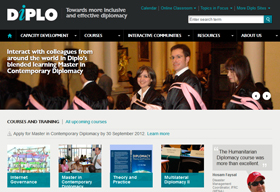
DIPLO was created in 2002 by joint efforts
of the governments of Malta and Switzerland
It should also be noted that digital solutions for diplomacy are developed and applied not only by foreign ministries, but also by international NPOs. For example, ediplomat.com is positioning itself as a global portal for diplomats. The portal publishes news and recommendations, and provides services to the diplomatic community. This portal was initiated by a group of diplomats, who realized the potential of the Internet and tried to ensure that this resource became a platform for bringing together the diplomatic corps and all those interested in diplomacy.
Another electronic resource – diplomacy.edu (Diplo) – was created in 2002 by joint efforts of the governments of Malta and Switzerland. Currently, Diplo offers electronic solutions for diplomacy and in general for public administration. On the site, one can review a number of studies on e-diplomacy, take online training in various courses starting from diplomatic protocol and ending with climate change.
In the age of mass communication, the number of people who use mobile phones and smartphones equipped with Internet connection is growing daily. In this regard, it is important to mention another useful feature of digital diplomacy – creating channels of direct communication with citizens going abroad in order to ensure communication in the event of a crisis. Russia already has experience in this area: August 1, 2012 marked one year since the beginning of co-operation between the Russian Foreign Ministry and Mobile TeleSystems OJSC (MTS) on informing Russian citizens traveling abroad. Arriving abroad, all MTS clients receive free text messages containing emergency phone numbers of Russian embassies. In addition, at the request of the Russian Foreign Ministry, MTS sends its clients located overseas notices and recommendations of the Russian diplomatic service in the event or threat of an emergency situation in a particular country. Certainly, work in this direction needs to be developed and strengthened by engaging other Russian mobile operators.
The example of cooperation between the Russian Foreign Ministry and MTS shows that Russia already has some experience in the field of digital diplomacy. As of August 2012, 45 Twitter accounts, two of which belong to Gennady Gatilov, Russian Deputy Foreign Affairs Minister, and Alexander Yakovenko, Russian Ambassador to the UK, were listed on the website of the Russian Ministry of Foreign Affairs. The interface of the website of the Russian Foreign Ministry has been recently updated and there are plans to create a page of the Ministry in Facebook. In addition, the Russian Foreign Ministry launched its first account in YouTube in June 2012. It plans to increase the number of embassy microblogs on Twitter. Yet there is still much to do. Information & communication technologies are constantly improving. Therefore, to fully work with the Internet audience, one needs to not only be able to use the available arsenal of digital diplomacy tools, but also to be aware of the latest trends and developments.
To use the resources of new social media it is clearly necessary to develop a strategy, train staff and analyze the situation. Typically, state agencies – because of their inertia – are much less receptive of innovation in the ICT field, in contrast to, for example, private business, which makes extensive use of new technologies and interacts with the external environment. Collaboration between the Russian Ministry of Foreign Affairs and Russian IT companies, such as Yandex, Rambler and the popular social media resource VKontakte could be a way out to some extent.
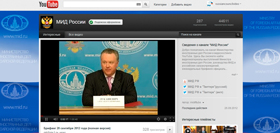
Russian Foreign Ministry launched its first account
in YouTube in June 2012
It will be recalled that the Russian Ministry of Foreign Affairs has such an educational resource as the Diplomatic Academy, one of the functions of which is to train and develop the Russian diplomatic corps. Digital diplomacy courses should be a mandatory element of the educational process in the academy. Moreover, if the staff of the central office of the Foreign Affairs Ministry are able to be trained directly in the academy, the staff of embassies and consulates should be able to study online in the form of webinars.
Thus, digital diplomacy and Internet activities as a whole can seriously strengthen the work on explaining the state’s foreign policy positions to domestic and foreign audiences. Digital technologies can be particularly useful in public diplomacy in the field of information collection and processing, in the field of consular activities, and for communications during emergencies and disasters.
Certainly, the Web 2.0 diplomacy has its risks, which include information leakage, hacking, and anonymity of Internet users. However, international practice shows that competent use of digital diplomacy tools can bring big dividends to those who invest in it. Moreover, digital diplomacy does not always require financial investments. On the contrary, it is often aimed at reducing costs. The human factor – the desire of employees to grow, master new technologies, spend part of their work time on working with the target Internet audience, processing electronic data, and creating information and reference materials – is very important.
The possibilities of digital diplomacy development are limited by the lack of a national information & communication strategy, insufficient trained personnel and a number of Internet-inherent risks. In addition, tools are required to assess the effectiveness of the social media used. What matters here now is not the number of “followers”, “likes”, and “tweets/retweets”, but real indicators of the audience response to messages, change in its perception and how this is promoted by the Web 2.0 diplomacy. Digital diplomacy will not replace classical diplomacy, but, if handled with skill, this tool can strengthen the work of the state in international relations and foreign policy. The future of the Web 2.0 diplomacy is being made already today, it is constantly developing, involving more and more participants in the information exchange process. This is facilitated by the very nature of social media, which like any living organism are constantly evolving.
For foreign ministries, the time for digital diplomacy is now. All that is left is for them to make a choice: stand idly and watch the changes occurring and lag behind in technological progress or accept this reality, and with it – the opportunities and benefits that e-diplomacy offers.
1. Zonova T.V. A modern model of diplomacy: the origins of formation and development prospects. – M. ROSSPEN, 2003.
(votes: 4, rating: 3) |
(4 votes) |


